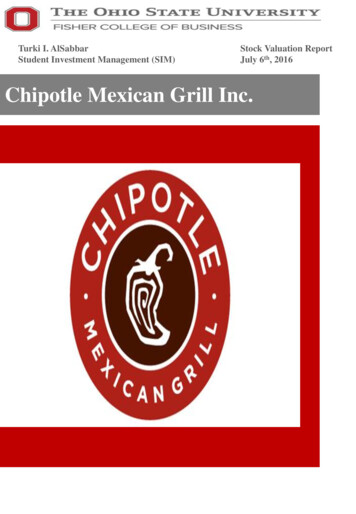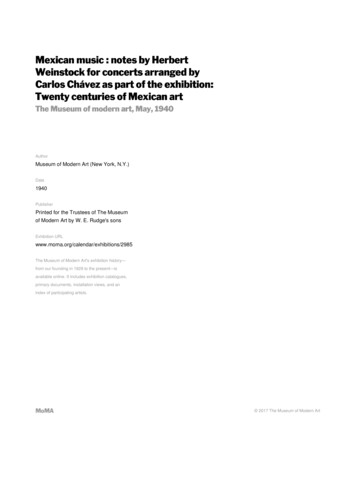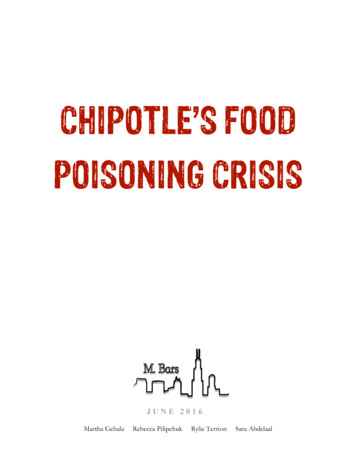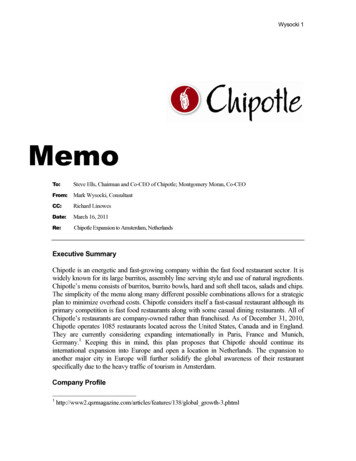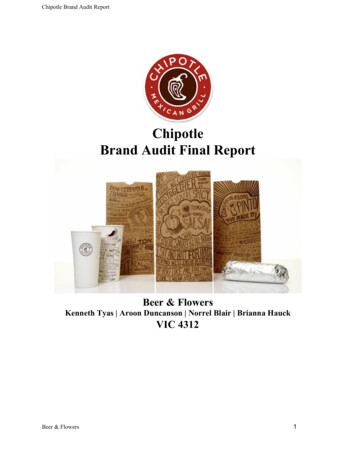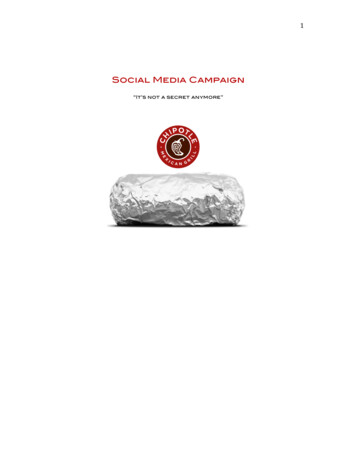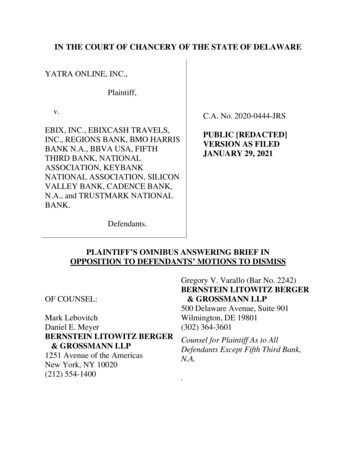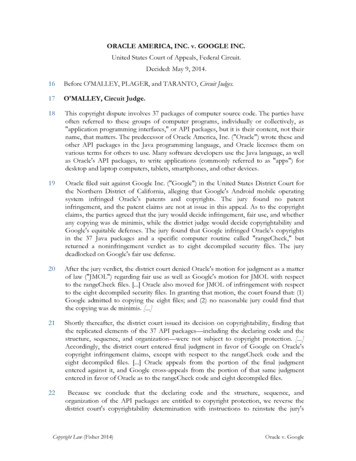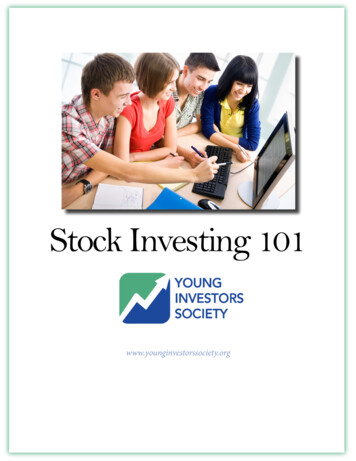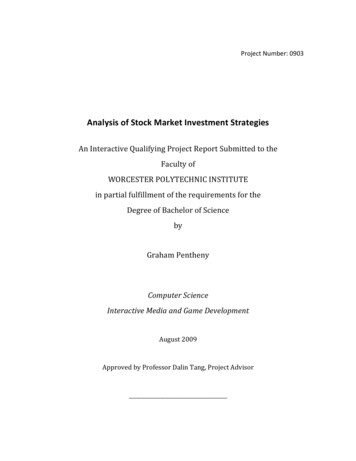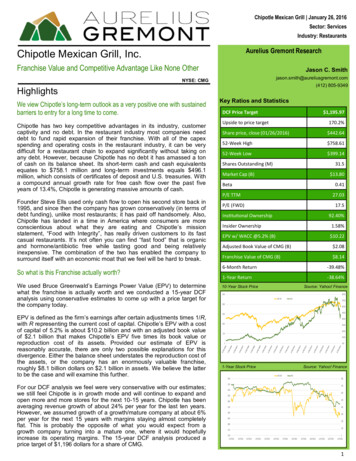
Transcription
Chipotle Mexican Grill January 26, 2016Sector: ServicesIndustry: RestaurantsAurelius Gremont ResearchChipotle Mexican Grill, Inc.Franchise Value and Competitive Advantage Like None OtherJason C. Smithjason.smith@aureliusgremont.comNYSE: CMG(412) 805-9349HighlightsWe view Chipotle’s long-term outlook as a very positive one with sustainedbarriers to entry for a long time to come.Chipotle has two key competitive advantages in its industry, customercaptivity and no debt. In the restaurant industry most companies needdebt to fund rapid expansion of their franchise. With all of the capexspending and operating costs in the restaurant industry, it can be verydifficult for a restaurant chain to expand significantly without taking onany debt. However, because Chipotle has no debt it has amassed a tonof cash on its balance sheet. Its short-term cash and cash equivalentsequates to 758.1 million and long-term investments equals 496.1million, which consists of certificates of deposit and U.S. treasuries. Witha compound annual growth rate for free cash flow over the past fiveyears of 13.4%, Chipotle is generating massive amounts of cash.Key Ratios and StatisticsDCF Price Target 1,195.97Upside to price target170.2%Share price, close (01/26/2016) 442.6452-Week High 758.6152-Week Low 399.14Shares Outstanding (M)31.5Market Cap (B) 13.80Beta0.41P/E TTMFounder Steve Ells used only cash flow to open his second store back in1995, and since then the company has grown conservatively (in terms ofdebt funding), unlike most restaurants; it has paid off handsomely. Also,Chipotle has landed in a time in America where consumers are moreconscientious about what they are eating and Chipotle’s missionstatement, “Food with Integrity”, has really driven customers to its fastcasual restaurants. It’s not often you can find “fast food” that is organicand hormone/antibiotic free while tasting good and being relativelyinexpensive. The combination of the two has enabled the company tosurround itself with an economic moat that we feel will be hard to break.So what is this Franchise actually worth?We used Bruce Greenwald’s Earnings Power Value (EPV) to determinewhat the franchise is actually worth and we conducted a 15-year DCFanalysis using conservative estimates to come up with a price target forthe company today.EPV is defined as the firm’s earnings after certain adjustments times 1/R,with R representing the current cost of capital. Chipotle’s EPV with a costof capital of 5.2% is about 10.2 billion and with an adjusted book valueof 2.1 billion that makes Chipotle’s EPV five times its book value orreproduction cost of its assets. Provided our estimate of EPV isreasonably accurate, there are only two possible explanations for thisdivergence. Either the balance sheet understates the reproduction cost ofthe assets, or the company has an enormously valuable franchise,roughly 8.1 billion dollars on 2.1 billion in assets. We believe the latterto be the case and will examine this further.For our DCF analysis we feel were very conservative with our estimates;we still feel Chipotle is in growth mode and will continue to expand andopen more and more stores for the next 10-15 years. Chipotle has beenaveraging revenue growth of about 24% per year for the last ten years.However, we assumed growth of a growth/mature company at about 6%per year for the next 15 years with margins staying almost completelyflat. This is probably the opposite of what you would expect from agrowth company turning into a mature one, where it would hopefullyincrease its operating margins. The 15-year DCF analysis produced aprice target of 1,196 dollars for a share of CMG.27.03P/E (FWD)17.5Institutional Ownership92.40%Insider Ownership1.58%EPV w/ WACC @5.2% (B) 10.22Adjusted Book Value of CMG (B) 2.08Franchise Value of CMG (B) 8.146-Month Return-39.48%1-Year Return-38.64%10-Year Stock PriceSource: Yahoo! Finance2500800.00S&P 0.00500100.0000.001-Year Stock PriceSource: Yahoo! FinanceS&P /201510/27/201511/27/201512/27/201501/27/20161
Chipotle Mexican Grill January 26, 2016Sector: ServicesIndustry: RestaurantsCompetitive Advantage: How is Chipotle differentthan any other fast casual dining restaurant?We feel Chipotle (CMG) is in an industry segment by itself.Chipotle operates in the fast casual dining space. Some ofits competitors include Shake Shack, Qdoba, Burgerfi,Moe’s Southwest Grill, McDonald’s and Taco Bell to name afew. But in reality the restaurants listed aren’t truly its competition. Chipotle operates in a niche market by itself. It offers healthy/organic/hormone free food in the Mexican restaurant industry. Taco Bell, Qdoba, and Moe’s might compete with them on the Mexican restaurant side, but they donot offer the same food choices Chipotle offers, and for thatreason we feel Chipotle has a true competitive advantagewithin its market segment. Today’s society wants “Food withIntegrity” as Chipotle puts it. Many of Chipotle’s customersare time-constrained office workers who are willing to paymore for CMG’s food. When Chipotle raised its prices backin 2014 many of its customers didn’t even notice the difference. If a burrito costs 6.00 one week and 6.75 the next,it wasn’t going to break it’s customers bank. Chipotle’s biggest customers are millennials, (people between the ages of23 and 36, 20% of the U.S. population) people who are willing to skip traditional fast food for the likes of Chipotle’shealthy eats. Most millennials prefer quality over price andwe aren’t just talking food quality. Chipotle’s customer experience is raved about by its customers and investors.Chipotle also puts in a ton of effort in recruiting and advancing employees within its organization. Chipotle takes time tofocus on hiring, training, and promoting employees fromwithin. And, by not franchising, Chipotle is able to offer better employee advancement. Managers at Chipotle canmake over 100k a year.Chipotle has targeted its marketing and branding campaigns on how the company differs from its competition. Itfocuses on marketing organic, locally-produced ingredientsand meat from “naturally raised” animals. This has ledChipotle to be able to deliver a product in a fast food spacethat has been different from most fast food restaurants.Chipotle’s product has also been strengthened by the shiftin consumer priorities to healthy, quality food. Chipotledoesn’t have to spend massive amounts on its marketingcampaigns because there simply aren’t many companiesoperating in its same space.Chipotle has built a brand and an image around a group ofpeople whom are extremely happy with CMG’s product.Chipotle was a visionary and saw an industry where its customers had a set of values that weren’t being reflected inthat industry; people will always want things done quickly,but they also care about the quality of the product as well.Chipotle’s strategy has ensured them with barriers to entryfor a time to come.Figure 18,000.07,000.0Total Revenues: CAGR 201120122013201420152016P2017P2018P 2019P2020PFigure 2Cash and Investments vs. .00.02010A2011A2012A2013A2014ACash and Cash EquivalentsInvestmentsLong Term InvestmentsTotal Liabilities2015AFigure 3Revenue and Operating 2,000.01,000.00.02011201220132014Total revenues20152016P2017P2018P2019P2020PTotal Operating Expenses2
Chipotle Mexican Grill January 26, 2016Sector: ServicesIndustry: RestaurantsCompetitive Advantage: Balance SheetStructureFigure 4Chipotle's Operating AssetsChipotle (CMG) has 2.5 billion in total assetswith current assets representing 35% of itsAccounts Receivable, netInventories, net60.01,400.0total assets. However, if you subtract out cashCurrent Portion of Deferred Tax Assets, netPrepaid Expenses and Other Current Assetsand cash equivalents then the current assets1,200.050.0Other AssetsGoodwillonly make up 4.7% of its total assets. Cash1,000.0PP&E, netand cash equivalents make up the biggest part40.0of Chipotle’s current assets, 86%, and also800.030.0account for 30% of its total assets. If you in600.0clude Chipotle’s “long-term investments”,20.0400.0which are certificates of deposit and U.S.Treasuries then its cash and investments10.0200.0make up 50% of its total assets (see figure 2).0.00.0The largest operating asset Chipotle has is its2010A2011A2012A2013A2014A2015APP&E which accounts for 44% of its total assets (see Figure 4, right axis value). If yousubtract PP&E out of CMG’s operating assets then operating assets only account for 7.3% of Chipotle’s total assets, andwhen included, operating assets make up 51% of Chipotle’s total assets. This compares to the industry average of almost90%. Chipotle is generating sales of 4.1 billion (see Figure 1) on 1.3 billion in operating assets. So one can see CMG ismaking great use of its operating assets. Chipotle’s return on operating assets is double the industry average, 34% versus17%. Since Chipotle uses fresh food and doesn’t hold on to its inventory very long, while also having its customers pay withcash, debit and credit cards, it is able to make great use of its cash conversion cycle which was minus 4 days for 2015.Chipotle’s management is doing an incredible job of managing of its working capital. This type of cash conversion cycle isusually seen in a software industry where cash is collected before products are delivered.Chipotle has 245 million in current liabilities which makes up 46% of its total liabilities. Accounts payable accounts for 100%of its current liabilities. Chipotle has no short or long-term debt and has financed all of its assets with equity. This compares tothe average debt to assets ratio of 69% for the industry. This is what separates Chipotle from the pack. Most companies needto fund its assets with debt in order to be able to expand, but chipotle has been able to grow without taking on any debt. Toreplicate Chipotle’s business model it would be almost impossible to expand as fast as Chipotle did without taking on anydebt. Even if a company did want to challenge Chipotle for market share it would almost certainly have to take on debt to doso. To be able to generate an EPV of 10.2 billion on 2.1 billion in assets is really an astonishing feat when you considerChipotle has no debt.Using a 69% debt to assets ratio, debt for an average entrant into Chipotle’s market would equate to 1.8 billion on 2.5 billionin assets. So assuming Chipotle would match the entrant’s debt to asset ratio, then this would bring CMG’s weighted averagecost of capital (WACC) to 3.8% based on 69% debt/assets and a 3% interest rate on the debt, which we consider fair considering todays interest rate environment (see Table 5). The new per share EPV would be 443.96, which is about what theshares are trading at today (see Table 5).Here we have clearly established Chipotle’s competitive advantages: its demand advantage is its customer captivity ,and itssupply-demand advantages with economies of scale is the fact that Chipotle has built itself this large with no debt. This enables CMG to earn more on its assets than possible in a more competitive environment. Chipotle is able to lower prices to alevel where it alone is profitable and can increase its share of the market or eliminate all profit from competitors who match itsprices (see Table 8). With Chipotle’s high degree of customer captivity and economies of scale in a market (organic/healthyMexican dining) where Chipotle doesn’t have many competitors, an entrant would not be able to catch up to them and wouldprobably stay on the wrong side of profitability if they chose to enter the market. So far there hasn’t been many entrants intoChipotle’s market; one could argue that Shake Shack, Burgerfi, Qdoba, and Moe’s occupy the same space as Chipotle. However, most of them do not. Shake Shack and Burgerfi do produce healthy food, but they are both burger places, and Qdobaand Moe’s do have the same style of Mexican food, but do not serve the healthy/organic style of food Chipotle offers.3
Chipotle Mexican Grill January 26, 2016Sector: ServicesIndustry: RestaurantsWhat is EPV and how did we get here?EPV is defined as the firm’s earnings after certain adjustments times 1/R, with R representing the current cost ofcapital. The adjustments are:Table 1 Undoing accounting misrepresentationssuch as frequent one time charges. zation,asreported by the accountants, and theactual amount of reinvestment thecompany needs to make in order torestore a firm’s assets at the end of theyear to its level at the start. Taking into account the business cycleand other transient effects. Applying other modifications as arereasonable,dependinguponthesituation.CMG Sales, EBIT, Net Income,and 8(0.5)(0.5)(0.5)(0.5)(0.5)EBIT Adjusted287.3350.1455.5532.3710.3EBIT Margin15.6%15.4%16.7%16.6%17.3%Net 0.8%Less AdjustmentNet Income MarginThe purpose of these adjustments is to arrive at a figure which represents free cash flow. Rather than making allthe necessary adjustments for 2015 because of the E. Coli problem, we conducted the analysis using 2014 figures.The adjustment for Chipotle was a 5 million dollar loss in credit card transactions as result of a security breach.Assuming this happens to Chipotle once every 10 years we subtract 500k for each year (see Table 1). The nextadjustment is for the business cycle; we went back to the Great Recession and saw the revenue growth rate onlydip slightly, so we did not need to adjust for cyclicality. Depreciation and amortization also did not require anyadjustments. Chipotle’s depreciation charge is small as a percentage of revenue because the company leasesTable 2most of its stores, so it doesn’t own a lot ofreal estate which would give it bigdepreciation charges. Looking at Table 2, wecan see Chipotle has had higher D&Acharges than what it is spending on itsmaintenance capex, which should beexpected from a firm that is still growing itsstore base. The biggest difference came in2014 and amounted to 88.5 million dollars.Looking at everything put together we canCMG Depreciation and Capital Expenditures2010A2011A2012A2013A2014ADepreciation andAmortization68.974.984.196.1110.5Maintenance 88.5Table 3CMG Adjusted EarningsEBIT AdjustedTax rateEBIT after taxDepreciation and AmortizationMaintenance CapexEBIT after tax adjustedNet 2014A710.338%442.9110.522.0531.4443.4see distributable cash flow (EBIT after tax adjusted) for 2014 was much different than the net income reported(see Table 3). The difference is about 88.0 million dollars. Once we calculated our adjusted earnings for Chipotlewe came up with our EPV value. EPV Adjusted Earnings x 1/R. We calculated our cost of capital R using thecapital asset pricing model (CAPM). Chipotle has no outstanding debt, so its WACC calculation is based on itsequity, with a Beta of 0.41, a risk free rate of 1.92% and an expected market return of 9.93%, its cost of capitalcame out to be 5.2% (see Table 4). Next we can determine our EPV with varying costs of capital (see Table 5). Asyou can see from Table 5 the varying cost of capital rates significantly change our EPV value.4
Chipotle Mexican Grill January 26, 2016Sector: ServicesIndustry: RestaurantsTable 4At a cost of capital of 5%, CMG’sEPV is 10.6 billion and if the cost ofcapital is 8%, then the EPV falls to 6.6 billion. Assuming our WACCcalculation is correct then EPV forChipotle is 10.2 billion. Since EPVassumes all capital is equity capital;it ignores interest paid on debt andinterest received on cash. InChipotle’s case there is no debt, sowe only need to add back the excess cash, bringing our EPV to 11.5 billion or 363.64 a share.With Chipotle’s EPV much higherthan the reproduction cost (see Table 6) of its assets, we feel Chipotleexhibits a significant competitiveadvantage with strong barriers toentry.WACC CalculationChipotleCompany Name: Current Share Price:442.60Risk-Free Rate1.92%Effective Tax RateBeta0.41ST DebtExpected Market Return9.93%LT DebtEffective Tax Rate:38.0%Market Capitalization ( B)Toggle Discount Rate (WACC):5.2%Cost of EquityMarket CapTotal Debt Value 13,800.0-Capital Structure 13,800.00Equity 13,800.0Bond Rate5.20%Cost of DebtWeight100%Cost5.2%0%0.0%Debt38%-0.0%0%Weight x Cost5.2%0.0%5.2%WACCTable 5Earnings Power Value of CMG with Different Cost of Capital Rates (net income 443.4 million)*assumption with a D/A ratio 69%Costs of .6*10,628.310,219.59,662.18,856.97,591.66,642.7Per us Cash-Debt Adjustment of .67,877.7Table 6CMG Reproduction Cost of Assets2014 Adjustment ReproductionAssetsCash and Cash EquivalentsAccounts Receivable, netInventoryCurrent Portion of Deferred Tax Assets,netPrepaid Expenses and Other CurrentAssetsIncome Tax ReceivableCurrent AssetsInvestmentsPP&E, netLong Term InvestmentsOther AssetsGoodwillTotal .1338.61,107.0496.142.821.9021.92,546.3Per ipotle has written off 1.2 million in bad debtsagainst its receivables, so a competitor would likelyexperience the same allowance. Inventory forChipotle is a combination of its ingredients, beverages, and supplies, and they are turned over veryquickly, so no adjustment is needed. AlthoughChipotle’s menu is not very extensive, one can seethat its customers are willing to a pay a premiumfor its menu items. Chipotle has spent a good dealon marketing its “Food with Integrity”, about 11% ofrevenue. And if a competitor was going to replicateChipotle’s business model they would have tospend much more, so we shall consider the item anoff-balance sheet asset. We assumed three yearsof marketing to get the competitor’s brand off theground, which equated to 1.3 billion of a quasiasset. If we total up all the assets we get a totalasset value for the firm of 3.9 billion. From this wesubtract spontaneous liabilities and deduct the excess cash, or cash in excess of what the companyneeds to run its operations (see Table 7).2,547.55
Chipotle Mexican Grill January 26, 2016Sector: ServicesIndustry: RestaurantsTable 7CMG Reproduction Cost of Assets, Including Adjustments for Cash and Non-Interest Bearing LiabilitiesTotal assets, as adjusted aboveThree years of marketing, promotionReproduction cost of all assetsMinus non-interest bearing liabilitiesMinus deferred rentMinus excess cash and investmentsTotal Reproduction CostReproduction ,082.2EPV with WACC of 5.2%Adjusted Book Value of CMGFranchise Value of CMG 10,219.52,082.28,137.3The Value of the FranchiseThe extra earnings power value between EPV and Chipotle’s (CMG) assets is called its franchise value (see Table 7). Here wehave established Chipotle’s assuredly high franchise value of 8.1 billion dollars on 2.1 billion in assets. In this case, we believe Chipotle to benefit from significant competitive advantages, which enables it to earn more on its assets than others in thesame competitive environment. So what would it take for an entrant to take market share from Chipotle? Even if a potentialcompetitor lowered its prices b
Mar 23, 2016 · price target of 1,196 dollars for a share of CMG. Aurelius Gremont Research . Even if a company did want to challenge Chipotle for
